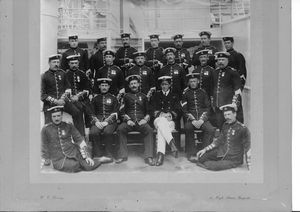Catalogue number 88
Royal Marines with their officer, early 1900s
These Royal Marines are posing with their officer in their red tunic dress uniform of the 1902 pattern and the Brodrick cap. They are mostly long-service men – left sleeve, two stripes for 6 years, three stripes 12 years and there are five men with four stripes indicating 18 years service. Almost all of them have won medals – considering the period, these medals were probable won during land battles. To the right of the Royal Navy Lieutenant is a colour sergeant – see right sleeve, three stripes and badge – and to the left is a corporal. Behind the corporal and to his right is a man with what looks like a marksman badge – crossed rifles – on the left sleeve..
Credit: W.C. Harvey
29.5cm x 24.8cm Sepia photograph mounted on cardboard
|
 |